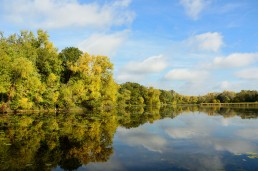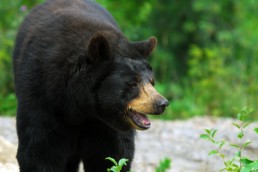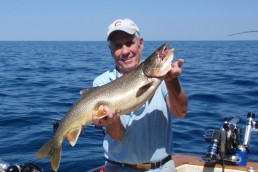Minnesota’s Outdoor Scene in the News
SHARE THIS POST
Moose population remains low, though survey suggests 6-year stability
Minnesota’s moose population shows signs of stability when comparing this year’s population estimate of 3,710 northeastern Minnesota moose with estimates since 2012, according to the Department of Natural Resources.
“At this point, results do not indicate that moose are recovering in northeastern Minnesota,” said Glenn DelGiudice, DNR moose project leader. “While it is encouraging to see that the decline in the population since 2012 has not been as steep, the apparent stability does not allow us to forecast the direction of the population’s trajectory into the future.”
The 2017 aerial moose survey estimate of 3,710 moose in the northeastern part of the state is statistically unchanged from last year’s estimate of 4,020. There is inherent uncertainty associated with survey estimates because researchers will never see and count all of the animals being surveyed across the vast landscape. Statistically, the DNR is 90 percent certain that the population estimate is between 3,010 and 4,710 moose.
Research by the DNR continues to examine the complex potential causes of a moose population decline that started about a decade ago. The research also suggests the recent signs of stability could have resulted from higher calf survival. Much remains unknown, but what is known are the factors including infections, parasites and other health issues that are killing moose and predisposing them to being preyed on by wolves.
The DNR releases an annual moose population estimate each year that can help indicate population trends but cannot predict future population levels.
Each year the population estimate is compared to 2006 because the state’s highest moose population estimate of 8,840 occurred that year. Currently, northeastern Minnesota’s moose population is estimated to be 58 percent lower than in 2006.
Studies have shown that adult moose survival has the greatest long-term impact on changes in the size of moose populations. The DNR’s moose mortality research project shows that survival of adult moose has remained between 85 and 88 percent from 2014 to 2016, a bit higher than the average of 81 percent during 2002 to 2008, and 81 percent in 2013. Wolves do prey on healthy adult moose and calves, although research data have indicated modestly higher calf survival in the past couple of years compared to 2013, which may be contributing to the population’s recent apparent stability.
Annual aerial moose surveys have been conducted each year since 1960 in the northeast. Adjustments were made in 2005 to make the survey more accurate and annual results more comparable.
This year’s survey involved flying 52 “survey” plots (13 square miles each) distributed across northeastern Minnesota from January 5-14. The Fond du Lac Band of Lake Superior Chippewa and 1854 Treaty Authority contributed funding and provided personnel for the annual moose survey.
Find more information go to mndnr.gov/moose or contact Glenn D. DelGiudice, moose project leader, at 651-539-3314.
Women can learn to bowfish through DNR classes
Women can learn the fast-growing pursuit of bowfishing through classes taught by the Land of Lakes Bowfishing Association, and part of the “Becoming an Outdoors Woman” program with the MNDNR.
“Bowfishing is a sport that is fast, fun and easy for all to enjoy,” said Patrick Kirschbaum, a bowfishing association member. “It’s a great way to improve your archery skills.”
Bowfishing involves seeing, shooting and retrieving fish using specialized archery equipment. People bowfishing in Minnesota can target common carp, buffalo, redhorse, sucker and other species that aren’t considered gamefish in Minnesota.
The class is free to attend but registration is required and attendance is limited to 30. After taking the first class, women can choose between one of two bowfishing trips: Saturday, May 6, in the Mankato area or Saturday, June 3, in the Alexandria area. That trip costs $50 to attend. To register for a class, contact Linda Bylander, DNR outreach program coordinator, at linda.bylander@state.mn.us or at 218-203-4347.
Are you enjoying this post?
You can be among the first to get the latest info on where to go, what to use and how to use it!
The Becoming an Outdoors Woman program offers a wide range of outdoors skill classes in fishing, hunting and outdoors sports. More information is available at mndnr.gov/bow. Printed copies of the annual events catalog are also available by calling the DNR Information Center at 888-646-6367 or 651-296-6157.
The regular bowfishing season opens statewide on Saturday, April 29. Bowfishing opened on February 27, with only from boats on lakes south of Highway 210 and on the Minnesota, Mississippi and St. Croix rivers. Bowfishing regulations can be found in the Minnesota Fishing Regulations booklet and in the online version at mndnr.gov/fishmn. Contact Susan Olin at Lake Bemidji State Park at 218-308-2329 or Amy Barrett at 651-259-5627.
Wet conditions force temporary road and trail closures
The MNDNR said it would need to close many roads and trails temporarily in state forests, state parks, recreation areas and wildlife management areas due to wet conditions. Many roads and trails are not firm enough to support vehicle traffic without being damaged. The temporary closures could remain in effect until sometime in May, depending on weather conditions.
“These are normal spring closures that happen when roads and trails become wet and fragile,” said Dave Schuller, state land programs supervisor for the DNR’s Forestry Division. “We ask that people use good judgment, obey the closures and check the DNR website for updates.”
Road and trail conditions can change quickly, and the DNR advises people to check individual state park, state trail or state forest webpages first before planning trips to avoid being surprised and disappointed by temporary closures.
Road and trail users should pay particular attention to state forest closures. Generally, all roads and trails in a particular forest will be closed, but not always. Those who can handle motor vehicle traffic will remain open, but may be restricted by gross vehicle weight. Signs will be posted at entry points and parking lots.
Schuller also noted that commercial loggers could continue to haul timber in the northern part of the state, which is not under Minnesota Department of Transportation spring load restrictions at this time.
“In unrestricted parts of Minnesota we have asked loggers to voluntarily not haul during the warm parts of the day to protect forest roads. Their compliance allows us to keep roads open longer.”
Online road and trail closure information is updated Thursdays by 2 p.m. Changes are added as soon as possible to the DNR website. Signs may be in place before the website is updated. All signs must be obeyed. Road and trail closure information is also available by contacting the DNR Information Center at info.dnr@state.mn.us or 888-646-6367, 651-296-6157, (8 a.m. to 8 p.m. Monday through Friday, and 9 a.m. to 1 p.m. on Saturday). Contact Patricia Arndt, Parks and Trails Division communications and outreach manager, at 651-259-5578, Amy Barrett, Parks and Trails Division information officer, at 651-259-5627 and Dave Schuller, Forestry Division state land programs supervisor, at 651-259-5255. For information on roads and trails on county land, contact the county directly.
Q&A
Q: What causes ruffed grouse numbers to rise and fall?
A: Grouse populations are known to fluctuate in a 10-year cycle in prime grouse range.
Numerous studies have been conducted to determine the cause of these cycles. Possible mechanisms that have been considered include predation, spring and winter weather, tent caterpillar’s affects on cover and forage quality, and parasites, to name a few. Some studies have found support for a relationship between raptor populations and grouse cycles. Northern goshawks switch between targeting snowshoe hares and grouse as populations of each of these prey species rise and fall. However, a 2008 study by researchers from University of Minnesota and the Ruffed Grouse Society reported that the most supported explanation for grouse cycles included winter precipitation and winter temperature. Grouse counts were highest during cold winters with lots of snow for roosting and during warm, dry winters. Conversely, grouse counts were lowest during warm and snowy or cold and dry winters.
A new study coming out this year by Pomara and Zuckerberg reports that population cycling can result from climate variability at more northerly latitudes. More specifically, temperature and precipitation interacts to influence demographic rates like winter survival to produce cycling.
MWO
SHARE THIS POST
You may also like...
Did you enjoy this post?
You can be among the first to get the latest info on where to go, what to use and how to use it!
MWO
We believe being outdoors is good. With more than 1,000 articles each year, MidWest Outdoors magazine is all about sharing outdoor experiences with you—where to go, what to use and how to use it… whether you’re close to home or on that trip of a lifetime.



